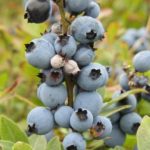Author – Robin Siktberg
The registration of a new broad-spectrum fungicide for blueberries and caneberries, such as raspberries and blackberries, is always good news for growers. Adding to the good news is the fact that this new fungicide has a zero-day preharvest interval (PHI). Given the number of fungal diseases that can affect these crops, having another tool for control can make a big difference in quality and yield.

Penthiopyrad, which is marketed as Corteva™ Agriscience Fontelis® Fungicide, is a FRAC group 7 broad-spectrum, reduced-risk fungicide that controls a number of foliar and soil-borne pathogens. Controlled diseases include Botrytis gray mold, Phomopsis twig blight, spur blight, yellow rust, late yellow rust, and mummy berry (in blueberries). FRAC group 7, the carboxamides, includes a fairly large group of fungicides, but pathogens have developed resistance to some. Penthiopyrad, which offers preventive, curative, and locally systemic activity, offers a new tool to use alone or in a tank mix on blueberries and caneberries. Fungicides should always be rotated in an IPM program by their mode of action, which is indicated by their FRAC group, to avoid development of pathogen resistance.
Optimal times to rotate penthiopyrad into an integrated pest management (IPM) program in cane berries and highbush blueberries are in spring and fall.
“For Botrytis, applications for both caneberries and highbush blueberries should be made when conditions are favorable for disease pressure – cool, wet conditions and high humidity — but prior to disease development,” says Kathryn Homa, Biologist-Plant Pathology & Regulatory Submissions for IR-4. “Conditions are favorable for Botrytis in the presence of free water during the spring in opened flowers, so an early application is beneficial at this time. Another time when conditions are favorable are if the weather is moist at harvest and during postharvest storage, so a late-season application is also a good idea.”
This is where the zero-day post-harvest interval is a big advantage. Penthiopyrad provides control of Botrytis and can be applied just before shipping or storage without worry about exceeding maximum residue limits (MRLs).
IR-4 Tests Penthiopyrad on Blueberries and Caneberries
In order to establish these MRLs and support a minor use label expansion for penthiopyrad on these crops, IR-4 conducted a study in partnership with Agriculture and Agri-Food Canada (AAFC). Trial sites were created in New Jersey, Georgia, North Carolina, Michigan, Quebec, British Columbia, Oregon, and California. Work was conducted according to US EPA or AAFC standards, depending on the location of the trials. An advantage of the two-country joint study is the registration of penthiopyrad in both the U.S. and Canada and harmonization of the MRLs.
Each trial site consisted of one treated plot and one untreated plot, with a 5-meter minimum buffer zone to avoid contamination of the untreated plot. In the US plots, the protocol was three foliar applications of Fontelis 200 SC (200g a.i./L = 1.67lb. a.i./gal) applied at 14-day intervals beginning at green tip onwards. In Canada, the same product was used at the rate of 0.313lb. a.i./acre at seven-day intervals. In the US, a surfactant (not a nonionic) was included at a labeled rate; Canadian trials included Enhance non-ionic adjuvant at 0.02% V/V. Normal production practices for blueberries, such as fertilization and irrigation were followed.
“According to the efficacy/crop safety reports and final reports for both blueberries and caneberries, there was no phytotoxicity observed in these trials,” Homa says. “The only disadvantage I see to [using penthiopyrad] is development of resistance, and that is somewhat dependent on the product being used properly in the field according to label directions.”
At the completion of the trials, fruit samples were collected from treated and untreated plots from each location. Samples were collected on the day of the third application after the spray had dried. All samples were submitted to the Food and Environmental Toxicology Laboratory at the University of Florida, Gainesville, and tested for residue levels.
US EPA approved the expansion of the penthiopyrad (Fontelis) label for blueberries and caneberries in March 2018, and AAFC approved it for Canadian use in May 2018.
Robin Siktberg is a Custom Content Editor for Meister Media; rasiktberg@meistermedia.com.
